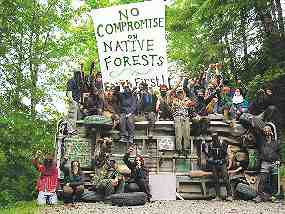The direct action-oriented Earth First! radical environmental movement and its public-facing arm, the Earth First! Journal, turned 40 years old in 2020. And, 2020 almost killed the venerable Journal.

The scrappy and irreverent publication was plunged into pandemic and quarantine hell, as its volunteers and tiny staff at its office in southern Oregon, used to working collectively in person, passing around articles being edited, was suddenly in chaos, navigating through poor internet in rural Oregon and steering over other considerable bumps in the road.
It is impossible to talk about the Earth First! movement without talking about the Earth First! Journal in the same breath. One of the unique aspects of the organization is that it is not really an organization at all, in that its infrastructure is minimal and horizontal by design. Aside from the magazine, the online “Earth First! Newswire,” and twice-yearly national gatherings, there is no central infrastructure. Rather, what constitutes Earth First! activity is campaign participation rooted in the underlying tenants of direct action, biocentrism and a declaration of “no compromise in the defense of Mother Earth.”
There is no doubt that Earth First! has stumbled over itself many times in its four-decade history, but it has been a forward-moving evolution for the most part, culturally and strategically. From its birth in a time when the environmental movement was as white as the driven snow, largely male, and rather insular, Earth First! has been risk-taking and bold, irreverent and self-effacing, and deeply committed to stopping the profit-motivated forces ripping apart the biological fabric of the earth.
Earth First!, and the Journal has stood with other species to the point of accusations of misanthropy, which are not totally unfounded. There were infamous heated debates with anarchist theorist Murray Bookchin’s crowd in the 1980s and 90s around his concept of social ecology vs. EF!’s deep ecology.
Criticism by some of individual actions that were labeled macho such as climbing to the tops of trees to protect them, and chaining oneself to heavy equipment. However, the larger activist community mainstreamed those tactics in subsequent decades.
Now, direct action, and environmental sabotage known by EF!ers as monkey wrenching, are employed in countless environmental campaigns, by many organizations. Even the stodgy Sierra Club engages in civil disobedience.
But where we have come, is to a framework for our organizing that’s being labeled Revolutionary Ecology. As the late and iconic activist Judi Bari, who was seriously injured by a bomb placed in her car in 1990 in retaliation for her Earth First! organizing put it: “Starting from the very reasonable, but unfortunately revolutionary concept that social practices which threaten the continuation of life on Earth must be changed, we need a theory of revolutionary ecology that will encompass social and biological issues, class struggle, and a recognition of the role of global corporate capitalism in the oppression of peoples and the destruction of nature. Biocentrism is a law of nature, that exists independently of whether humans recognize it or not.”
The theory is deep ecology, and it is the core belief of this radical environmental movement. Deep ecology, or biocentrism, is the belief that nature does not exist to serve humans. All species have an inherent right to exist for their own sake, regardless of their usefulness to humans. And, biodiversity is a value in itself, essential for the flourishing of all life—both human and non-human. A revolutionary ecology movement must also organize among poor and working people.
Biocentrism is ancient indigenous wisdom. But another unique aspect of Earth First! is that biocentrism, rather than anthropocentrism, is the underpinning of its campaign strategies.
As we claw our way out of the pandemic and politically toxic year of 2020, a handful—or fistful—of us are working to get back on a publication schedule for the Journal and the online Earth First! Newswire. People working on it are fiercely committed because there is not another place to go, to find a group organizing compromise-averse direct action, the strategy filtered through a biocentric lens. If the Earth First! Journal disappears from the landscape, the same campaigns would be there; the people would be there; along with the tactics and strategies. But it is a movement, a commonality of purpose and philosophy and cherished values that binds together a bunch of affinity groups wearing Earth First! t-shirts.
Given the absence of a formal infrastructure, it is not clear how the Earth First! movement, as resilient as it is, would survive the loss of its networking tool, its infra-organizational communication tool, its public face.
I hope readers of the Fifth Estate will check out the Journal. EF! merchandise is online, so you can adorn your torso with an Earth First! shirt, or other spunky trinkets. What is most needed is subscribers.
Subscribe now in time to receive the pulled-out-of-the-ashes 40th anniversary special issue that will relaunch our publication schedule. It will put radical history and a radical future in your hands and help Earth First! re-emerge on the scene renewed, bold, and ready to defend the earth with everything we’ve got.
The Journal can be reached at Earth First! Journal, P.O. Box 411892, Kansas City, MO 64141, and online for subscriptions, merchandise, information, and donations at earthfirstjournal.news.
Karen Pickett has been a grassroots activist for over four decades, organizing on ecological, civil liberties and social justice campaigns, engaging in direct action strategies, alliance building, and skills training, and community resilience. She is also a writer and editor, and working on a book about the radical environmental movement.
